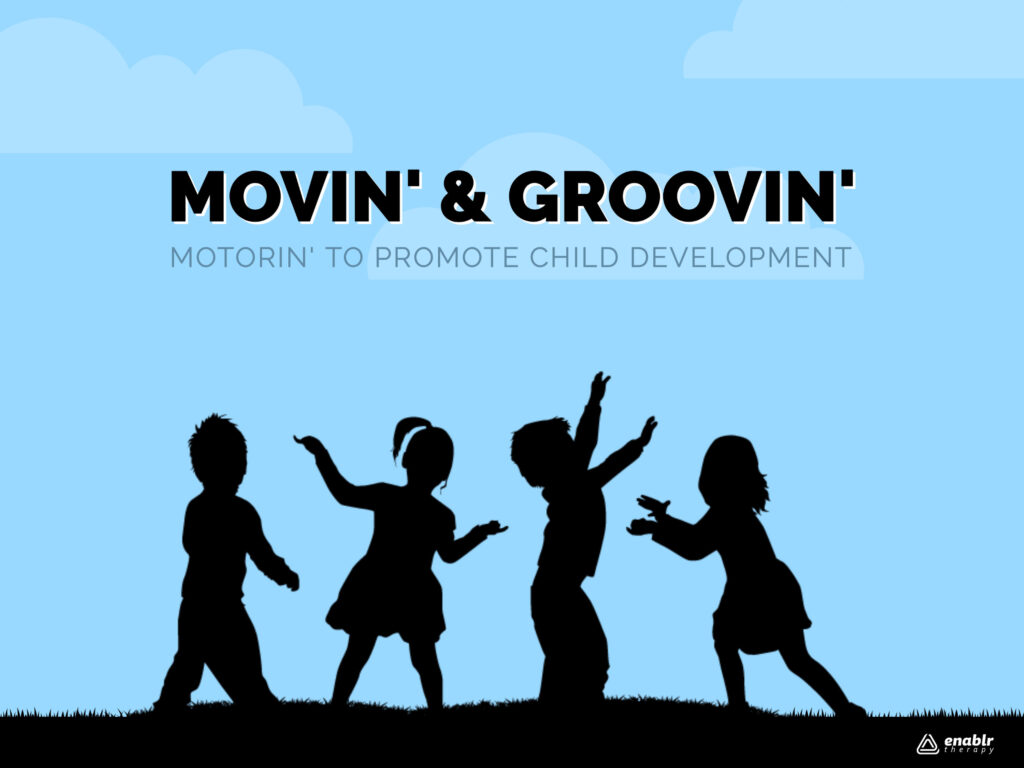
Gross motor skills usually elicit visions of children rolling, sitting, crawling, walking, running, jumping and skipping. But gross motor skills are vital for more than just moving. In fact, they are foundational in developing many other aspects of a child’s development including fine motor skills, overall physical and mental health, and language and cognition. The body and mind are connected.
Concerned about your child’s gross motor skills? Click here to view our therapy services!
Fine Motor Skills
When a child is able to efficiently move into and hold different positions like sitting or standing using core muscles, the child then has the stability and support to reach out with their hands to explore the world around them. Without strong gross motor development, children do not have the foundational security to interact with their surroundings and tend to have more difficulties with fine motor skills needed for everyday activities like play, dressing, and school activities.
For example, having a good sitting posture and shoulder stability are important for handwriting. To understand the impact that gross motor skills have on handwriting, try writing your name while slouching in a chair and lifting your feet off the ground. In this position, the body leans into the arms and hands to help with posture and balance, decreasing the freedom of the hand and fingers to move while writing.
A child with poor gross motor skills can experience this same effect in most daily activities. Being able to maintain posture and move easily allows a child to shift their focus from their body to the people and things around them, opening their world and providing opportunities for refining fine motor control.
Physical and Mental Health
The more easily a child can move around, the more likely the child will move. If a child feels clumsy or awkward, the child is less likely to engage in those movements or activities. Freedom of movement promotes overall physical health. Some research suggests that kids that have higher motor proficiency also have better fitness throughout their lifetime. Kids that are inactive tend to become inactive adults.
In addition to improving physical health, movement and exercise have been shown to improve mental health. Physical exercise can reduce anxiety, improve mood, increase energy levels, promote sleep and improve self-esteem and confidence.
Language and Cognition
Physical activity improves brain function and facilitates the creation of neural connections needed for learning. Some neural pathways that are laid down for motor movement are also used for other cognitive processes. Research shows that attention, memory, visual spatial skills, mental agility, language, and other cognitive processes are improved when children are given opportunities to move prior to or during the learning activity. Some studies have shown a positive correlation between increased physical activity at school and increased academic performance.
Gross Motor Development
Many believe that children will naturally develop and master gross motor skills as a child grows. Although some children do, others do not. Typical childhood physical development does allow a child to learn movement skills but at a basic level, not necessarily skill mastery.
All children need opportunities to move and practice movement throughout their day. Practice leads to mastery. The CDC recommends at least 60 minutes of moderate to vigorous physical activity for school aged children each day.
But even with activity, a few children need extra help learning movement patterns that are efficient and effective. Closely observe your child. If you notice that your child has some awkward or clumsy movements, try modeling the movement with them and allowing for further practice. If you notice that your child has ongoing issues with movements that are awkward or uncoordinated, consider consulting with a physical therapist.

References
CDC (n.d.). Physical Activity for Different Groups. Retrieved from https://www.cdc.gov/physicalactivity/basics/age-chart.html
Fedewa, A. & Soyeon, A. (2011). The Effects of Physical Activity and Physical Fitness on Children’s Achievement and Cognitive Outcomes: A Meta-Analysis. Research Quarterly for Exercise and Sport, 82 (3), P. 521-535.
Zeng, N., Ayyub, M., Sun, H., Wen, X., Xiang, P., & Gao, Z.. (2017). Effects of Physical Activity on Motor Skills and Cognitive Development in Early Childhood: A Systematic Review. BioMed Research International. Retrieved from https://www.hindawi.com/journals/bmri/2017/2760716/


